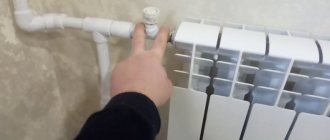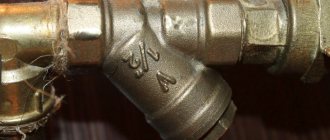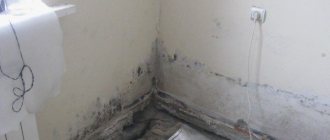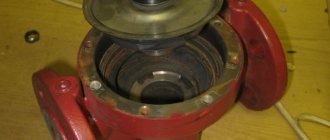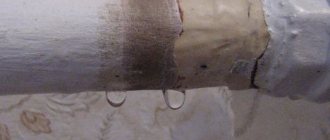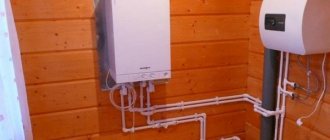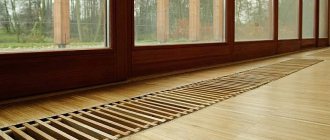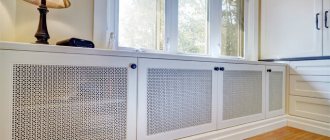Causes of the problem
Most often, “cold bottom” can be found in old radiators, but not only in them. If you install a bimetallic radiator, there is also a chance to detect such an ailment. There are quite a lot of reasons for the occurrence of a “cold bottom”, so you need to look at the main ones.
Human factor
A person can also become the direct cause of a non-heating radiator. And usually they are as follows:
- A riser that they simply forgot to turn on because “it was late and the plumbers were tired.”
- Closed valve of the automatic air vent system.
- Incorrect connection during installation.
- Child-closed three-way valve.
They can be solved by calling the appropriate support service, correctly connecting the battery (or bypass, see below), and carefully checking the taps.
Clogging
The most common reason for this phenomenon is clogged radiators. Here are other reasons why there is a strong temperature difference in the battery: low quality coolant and air getting inside.
This phenomenon can also be affected by the liquid inside the radiator, since it contains various solid particles. While the heating season is just beginning, excess elements may be present in the water, which makes its quality terrible.
If there is an individual heating circuit, then the water will not have such disadvantages.
Why can air affect the temperature at the top and bottom of the battery?
- Because special bacteria are involved that can only live in an environment saturated with oxygen.
- Such bacteria are also called anaerobic.
- Microorganisms themselves do not cause harm to the radiator.
- The damage is caused by their waste products, which settle at the bottom of the radiator as sediment.
Also, silt can settle at the bottom, which gets there from the entire heating main.
Another reason is the special design of the heat exchanger. Because of this, there are places in its shape where dirt accumulates.
Tips and tricks from experts
To improve the efficiency of heating devices, experts give simple but useful recommendations. To avoid the problem of “tops and bottoms”, adhere to the following rules:
- Regularly clean from rust and mucous deposits inside.
- Do not install it yourself.
- When installing, correctly calculate the number of sections. Don't put it in reserve.
- To ensure that warm water is distributed evenly, in a multi-story building, connect radiators in a diagonal pattern.
- Soldering of joints must be done by a specialist. Errors in connection often lead to section overlap and even complete obstruction.
To improve heat transfer, empty the batteries as much as possible. Remove protective screens and curtains. Radiators must not be touched by any parts. Otherwise, the heat will go into the structural element. And even more so, you shouldn’t hide them in a load-bearing wall, as my neighbor did.
Important: do not sound the alarm ahead of time. Steady heating after the first switching on appears within 3–4 days.
Problems with shut-off valves
Shut-off valves can also affect the temperature difference at the top and bottom of the radiator. The function of this element is to shut off the working fluid.
What does the shut-off valve consist of? It consists of a ball valve, a cone valve and a thermal head.
- The bottom of the battery becomes cold if problems occur with the tap.
- You should pay attention to one small detail: all taps have an arrow that indicates the direction for the liquid so that it moves without causing breakdowns in the line.
- If the tap is initially installed incorrectly, then the position of the arrow can be any, it does not play any role. Thus, due to a broken faucet, the fluid does not circulate properly. Incorrect installation of fittings can also affect the temperature difference.
It is necessary to inspect the shut-off valves as a preventative measure. It happens that some of its types require a special valve position. Therefore, it will have to be reinstalled.
Low temperature
If the difference in the temperature conditions of the bottom and top of the batteries is not too significant, then there is no need to worry. This arrangement of radiators is quite natural. The circulating coolant always has time to cool down a little, which is due to fairly high heat output rates. Very large discrepancies may require system intervention.
If the water temperature in the heating system is low, then it will be necessary to increase the heating of the coolant by increasing the power of the operating heater. A good result is also achieved by using a special heat-reflecting screen. For this purpose, it is recommended to use traditional aluminum foil or modern and reliable material such as penofol.
An important point with a two-pipe connection is the ability to regulate the temperature in a separate battery using special fittings, represented by a conventional shut-off valve. This ensures an increase or decrease in the volume of coolant in each radiator by adjusting the shut-off valves.
Lack of pressure
The circulation of fluid in the system may be disrupted if there is not enough pressure. This is another reason why the temperature at the bottom of the battery is lower than at the top. Therefore, you need to check if everything is normal with the pressure. In the USSR, batteries were made of cast iron.
Unlike today's models, in those days the passages were wider, which did not require much pressure.
The problem is that the pressure required for modern batteries is quite high, and the line is designed for old Soviet batteries, which cannot offer this pressure to users. Therefore, the working fluid cannot pass through the entire heat exchanger. However, the pressure may be insufficient not only because of the line.
- It happens that neighbors decide to experiment with heating.
- Among such experiments, we can highlight the connection of a heated floor, which takes water from centralized heating.
- Neighbors can also increase the volume of the heat exchanger and regulate their batteries.
- Therefore, a sufficient number of reasons for the temperature difference in the radiator come from neighbors. Moreover, connecting underfloor heating in apartment buildings and increasing the volume of the heat exchanger are prohibited by law.
- All of the above actions reduce the pressure in the line, which makes the bottom of the radiator cold.
You should be wary of “masters” who, having read the forums, advise installing shut-off valves on the bypass. You can't do that. If the authorities find out about such manipulations, they will have to bring everything back to the original fine and pay a fine. If the authorities find out about the installation of heated floors in an apartment building, they may even give a real deadline.
The battery is clogged
The formation of a blockage in a heating device is one of the most common causes when the bottom of the radiator is cold and the top is hot. The reason is the insufficient quality of the thermal fluid. The water supplied to the heating system often contains impurities, which, under the influence of high temperature, form into plaque that accumulates on the inner surface of the radiators.
The result of the blockage is a disruption in the movement of the heated coolant through the radiator and its uneven heating. To eliminate circulation problems, you can use mechanical and chemical methods to clean the radiator. In the most difficult cases, specialists often use hydrodynamic and hydropneumatic methods, as well as highly effective electro-hydropulse cleaning of batteries.
Not enough coolant speed
If the speed of movement of the working fluid is low, this will lead to its cooling.
The bottom of the battery will be especially cold. Why can water move slowly?
- At some point in the pipeline there is a narrow cross-section (most likely, the polypropylene pipes are poorly soldered).
- The liquid initially moves slowly (most likely due to insufficient power of the circulation pump or due to its breakdown, or if there is no circulation pump at all).
- Old pipes can accumulate deposits that impede the normal flow of fluid.
Reasons why the battery in one of the rooms does not heat:
No heating at all
In a private home, the cause may be a failed circulation pump, a disconnected power supply for such a pump, or a non-working heater or coolant boiler. There can be many reasons and all of them are in the boiler room. Only a specialist can understand most of them.
Airing
(filling with water)
If there is heating in the riser, but there is none in the radiator, then this is one of the possible reasons. A Mayevsky valve is used to bleed air from the radiator. If the riser is cold and the radiator does not heat, but the neighboring ones are hot, then most likely there is air in the entire riser. In order to bleed the air from the riser, a specialist from a service company is invited. He should do the same manipulation with the air vent at the top of the riser, most likely in the attic.
The taps on the radiator are closed
A common cause is closed taps on the radiator or a closed thermostat. Their internal parts turn sour and do not turn. To check whether the valve or thermostat is open, turn the knob or thermostatic head. They must not move separately from the damper stem or valve ball.
If this still happens, then you need to remove the handle or thermal head and use a wrench rather than pliers, for example, carefully try to turn the valve stem or thermostat. If unsuccessful, call a specialist to replace the failed fitting
The three-way thermostat valve is clogged
The next reason may be clogged internal parts of the three-way valve of the thermostat. Once installed on the radiator, you can try to remove dirt by turning the valve in both directions several times. Friction inside can help the water flow to break away accumulated sediment.
Incorrect pressure balancing of a two-pipe system
A special case can be considered the imbalance of a two-pipe heating system. With such a system, each radiator is connected in parallel to the forward and return pipelines. Circulation in such a system depends on the pressure in each specific section, and often the radiators at the “end of the path” no longer have sufficient pressure at the direct inlet, which disrupts the circulation. To regulate this, balancers or balancing valves are installed.
Balancing can also be done using thermostats by “pressing” the first radiators and “releasing” the last ones. If self-balancing does not work, you should call specialists.
https://youtube.com/watch?v=c_sCwFqL4b4
Cold
The radiator may have a cold bottom if it is installed in a room with low temperatures. Or if it is installed on a loggia or veranda. In cold weather, the liquid in the batteries cools much faster.
Bypass, what is it?
An effective device was invented for a normal microclimate in the house. Essentially, a bypass is a jumper installed between the return and direct wiring in the heating radiators.
A half-inch pipe is regularly used for this. A bypass is needed to return excess coolant. Without this device, it is very difficult to repair operating heating systems.
Diagonal or parallel connection of the coolant at the top and “return” at the bottom is the best option
Fixing the problem
Is it possible to somehow eliminate this shortcoming? First of all, you should check whether the supply and return are not confused.
Perhaps the root of the problem lies in a bad faucet.
- It should be replaced with a new one, which will have a wider longitudinal section.
- If the problem persists, replacing the heating pipes with new ones with a larger diameter will help.
You can also increase the speed of movement of the working fluid by installing a circulation pump in the line.
By following these tips, you will be able to get rid of the temperature difference in the battery.
Briefly about the heat supply of an apartment building
If you have the courage to figure out on your own why the batteries do not heat well, it would be a good idea to familiarize yourself with the basic concepts associated with heating a residential apartment building.
Most high-rise buildings use a single-pipe system equipped with U-shaped risers. Let us show a conditional diagram of the heat supply of three floors.
Hot water (red in the diagram) rises through one riser and passes, for example, through the bedrooms, to the top floor, where, in a loop, it goes down through other rooms (blue). This scheme has been designed since Soviet times for the use of cast iron radiators. Hot water enters the lower radiator manifold and, after passing through all sections, leaves the battery through the upper manifold.
A special role was given to jumpers (bypasses). They maintained general forced circulation throughout the entire pipeline of the U-shaped riser (in the diagram - for the six radiators shown), acting as a safety net in cases of radiator clogging with liquid technical dirt that accumulates during many years of operation. When passing through the riser, some part of the total displacement of hot water supplied from below turned to the radiator on one floor, and the rest passed by unhindered, delivering heat to the apartments adjacent to the riser.
The aluminum heating radiators that have appeared are designed for two-pipe systems with hot water supplied through the upper collector and its output from the lower collector. They have a completely different design of the internal cavity, and accordingly, different hydraulics. When they began to indiscriminately replace obsolete cast iron radiators with modern aluminum ones, but maintaining a single-pipe design, the heat flow from hot water inside the radiators began to weaken due to the divergent directions of convection heat flows from the cooling water and the hot water pumped by an external pump.
Concerned that the heating radiator was not heating up, residents began to resort to various technical tricks, not caring at all about their freezing law-abiding neighbors. This inconsistency between the types of structures and the decrease in the speed of water passing through the radiator led to dirt deposits in the sections. Every year more and more sludge is deposited, and now the last battery, completely clogged with sludge, no longer heats. This epidemic then covers the entire radiator.
Photos of the best heating radiators
Where to go if the radiators are a little warm, but there is no trust in local housing and communal services representatives
After submitting a claim, you can wait a week, unless cold weather and life circumstances (for example, the presence of small children or weak health members in the family) force you to act earlier.
If there is no proper response, such a complaint should be sent to a higher authority - the district housing inspection or Rospotrebnadzor. To the document it is necessary to add information about the actions taken previously, a copy of the first statement, reporting the lack of an appropriate response from the FSW.
In case of repeated silence, the next authority will be the prosecutor's office. The submitted complaint must be accompanied by documentary evidence of the futility of previous attempts to resolve the issue and provide information about the harm caused by the inaction of officials to residents of the apartment.
You can also go to court, but cases are not considered quickly and it is better to go there after resolving the main part of the issue, presenting a claim for compensation for material and moral damage.
Citizens faced with such difficulties often express the opinion that it is useless to contact the local housing and communal services, advising them to act immediately through higher-level authorities or send the original complaint to the management company, and at the same time copies to all other regulatory organizations.
Each case is individual, and it is impossible to make unambiguous prejudicial judgments about all organizations of this kind. The scale and intensity of action taken depends on many factors. How persistently and where to complain about cold batteries, what to do in a particular case - everyone decides for themselves.
Prevention
To avoid problems with air locks, it is necessary to install air vents at each group of heating elements. So, for example, to remove air from the boiler, an automatic valve for removing gases is mounted directly on it. All collectors are also equipped with it. Mayevsky taps are installed on the radiators at the end.
If, after bleeding the air, the radiators still do not heat up well, the coolant should be completely drained. Since it is possible that there is too much dirt in the network, and it significantly reduces the circulation of fluid in the batteries.
Diameter matters
If a bypass is not provided when installing the heating system, and the battery is simply connected to an existing riser, there may be problems due to the diameter of the pipes.
When passing through the riser, the flow of water is divided. If a pipe with a smaller diameter than the riser is connected to the radiator, little coolant will get into it. It will cool down quickly and the battery will feel cold or barely warm to the touch.
There are two solutions:
- Replace the pipe from the riser to the battery with a similar one, but of a larger diameter;
- Install a bypass and close it enough to reach the desired temperature.
